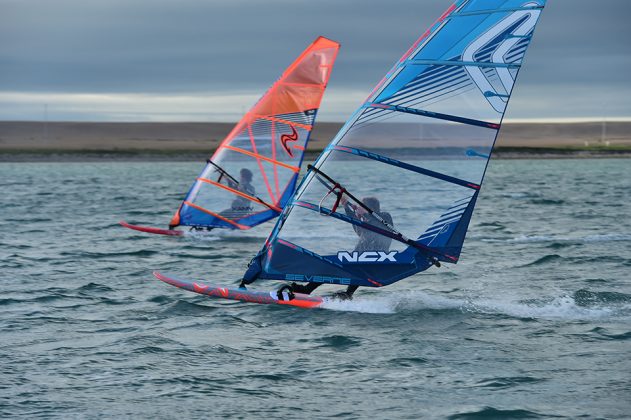THE MAGNIFICENT SEVEN
7.0M FREERACE NO-CAM SAIL TEST 2019
Test Editor Tris Best // Second Testers Maurin Rottenwalter & Joe North
Photos Alex Best & Andy Stallman // Test location Portland Harbour.
There is nothing quite like going flat out on a windsurfing board. It is very likely to be the reason most of you reading this were drawn to the sport in the first place. In the sport’s brief history, if you took a snapshot from any activity-focussed beach with a variety of watersports going on, it would always be the windsurfer that would grab the attention and limelight. Your eyes (and the cameras) naturally follow whatever is moving the fastest!
This test was originally published in the April 2019 issue.
It is true that kitesurfing has made a concerted effort to barge in and steal windsurfing’s thunder since its inception … and we have to begrudgingly admit it has done a reasonably good job! And yet, if you compare the capabilities of the average windsurfer against that of the average kiter, we would argue that the windsurfer would beat their adversary in a drag race, hands down. That’s because speed is more accessible in our sport … the king of watersports!
FINDINGS
To reach optimum speeds, there is no alternative but to opt for cammed sails, (despite reading some of the marketing literature for these no-cam sails!). But with specialist cammed sails comes a degree of expense, not to mention the technical input required to rig, tune and sail them. It is one commitment too far for most recreational sailors with limited time and resources, when all they really want is to simply get out on the water for a blast. Hence the market demand for no-cam freerace sails, aimed squarely to provide maximum reward for minimal technical, physical … and fiscal input.
To achieve faster speeds, the simple key ingredient to add is more wind. The more pull there is coming through the hands, the greater the chance of being able to push the board on to greater speeds. Yet with more pressure, the more significant the threat of the sail losing its form and structure. Over years of iteration and development, the most conventional solution adopted by most lofts was to pre-bend the mast, by increasing the sail’s luff curve. The resultant increase in skin tension, helped to lock the sail’s centre of effort in place and mitigate any decay at the top end of the sail’s wind range. But there was a negative consequence to loading the mast and leading edge of the sail, the stability achieved coming at the detriment of the sail’s bottom end power, light handling and animation. In marginal winds, such a highly tensioned rig simply felt dull and unresponsive in the hands … heavy even. And so the search commenced for a change in method and pathway – a way to breathe more life into the sail and increase its range without impacting upon top end performance or speed potential. For the past three seasons or so, most have gone down the route of reducing their sail’s luff curvature, using seam shaping and new material technology to stop any structural rot. And as time passes, new concepts emerge, changing the location of seams so that the skin tension can be determined accurately in more of the sail’s panels. In doing so, the twist pattern of the sail can be controlled, meaning the whole sail is more connected and efficient.
Another concept explored by some is changing the location of the sail’s centre of effort. Again, the accepted place to focus the pull is low down and forward in the draft, ensuring that the power delivered is manageable in overpowered conditions, helping to pin the board’s nose to the surface of the water. In marginal winds, however, this concept creates early planing limitations, as the sail’s power is still pinning the board to the ground, when you actually want the board to lift and release as early as possible. Some brands have therefore experimented with raising the location of the sail’s sweet-spot, pushing the draft further forward or employing specific materials to maintain stability. Others have kept the shaping low, yet moved it further back, next to the rider’s stance so that the power is more obvious in both hands. There is certainly no right or wrong, but the position of the power and the method adopted for locking it in place certainly changes the feel and character of each sail.
There are a couple of sails in the test group that feature yet another method by being recommended for use on 430 cm masts. There is of course the added practicality of facilitating a mast that many may already have in their quiver (thereby reducing cost), but the development is further reaching than that. With a softer leading edge, the sail can again flex and breath more easily, providing the response in marginal winds, without the need to compromise the brand’s preferred luff curve.
And there’s one more consideration we feel compelled to mention. With the continued growth and adoption of foiling within windsurfing, a 7.0m no-cam sail could be the perfect addition to your quiver to make the most of light breezes this summer. Some of the sails here would make inspired windfoiling engines, whilst others may not be so suited. The secret lies in the location of the centre of effort and where the pull is likely to be felt; as a general rule, the higher the location (which tends to correlate to being further forward too), the better the sail will be for foiling. So if you’re aiming to get flying this summer, it is certainly a point worth considering.
SUMMARY
Within the eleven sails on test here, there are some very different styles and characters. The GA Sails Matrix is a freeride beast, feeling large and useful in marginal winds, its Dacron luff panel and low centre of effort providing comfort and familiarity. The Duotone E_Type by contrast has its pull placed much higher in its draft. Light to handle, it feels alert and playful for such a big sail, with definite potential for crossover into foiling. Another sail with certain foiling capabilities is the Cheetah from Ezzy, its deep profile and reduced luff curve providing feedback at the earliest opportunity. A fantastic all-rounder with an extraordinary range, it can then be tuned and re-tuned again as the wind increases. Talking of all-rounders, we have to mention two others here – the Loftsails Oxygen and Simmer VMax. Both use 430 cm masts as standard and both have impressive wind ranges. The VMax offers more bottom end, whereas the Oxygen is focussed on supreme top end control… but both have compact natures and felt at home in challenging coastal seas. The Goya Mark Pro and Gunsails Rapid could both be described as fast freeride options. The Goya has a crisp direct nature as opposed to the built in softness of the Gunsails. Both power well in marginal winds, have low locked centre of efforts and can cover distance in comfort. With the tuning available, they are both naturally fast, capable of keeping up with all but the freerace specialists of the group. Talking of which, the Neil Pryde Speedster and Point-7 AC-X are two prime examples. Both are scintillating to use off the wind and keep accelerating and engaging the rider through every gust. The Neil Pryde may require a little more technical input to really master, whilst the Point-7’s pull position requires a bit more brute force to trim and maintain … but both will keep you champing at the bit, and coming back for more. The Severne NCX has a very different freerace character – whilst undoubtedly offering more range than its predecessor, its handling is still so subtle and forward focussed that its ease of use makes light work of powered and overpowered conditions. That leaves the RRD Fire, now in its seventh generation. Blessed with the capability of keeping up with any other sail here, we have to say we were blown away with the Fire’s apparent ease of use and efficiency. Hats off to RRD sail designer and all-round nice guy John Skye – he’s created a giant killer here!.
THE LINE UP



